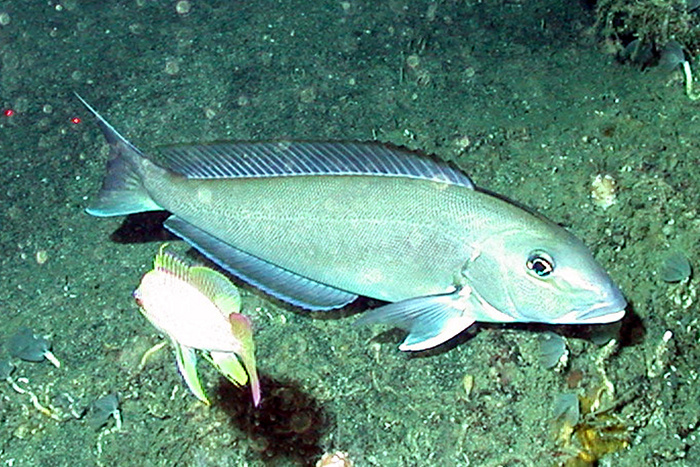
by Rick O'Connor | Mar 24, 2022
I am going to be honest and say that I know very little about this fish. I did not know they even existed until I attended college. Shortly afterwards, my father-in-law asked “hey, have you ever heard of a tilefish?” – to which I responded yes… He was having lunch at a restaurant in Apalachicola, and it was on the menu. My father-in-law was an avid fisherman and knew most of the edible species, but he had not heard of this one. The rumor was that it was pretty good, though my father-in-law chose not to eat it that day.

Tilefish
Photo: NOAA
I have never seen it on a menu, and only a few times in the local seafood markets, but according to Hoese and Moore1 by the late 1970s there was a small commercial fishery for this fish emerging in Louisiana, as was a small recreational fishery. In Florida, since 2000, there have been 15,435 commercial trips for this fish with an average of 321 each year. The value of this fishery over that time is $33,118,554 with an average of $689,969.90 each year. The average price for the fishermen was $2.62 per pound with the highest being $5.14/lb. on the east coast and that in 2022; the Gulf fishermen are getting $4.16/lb. right now.
The highest number of landings per county since 2000 was 340 in Palm Beach County in 2000. Only eight times has there been more than 200 landings in a single year over the last 22 years. Five of those were in Monroe County (Florida Keys) and three were again in Palm Beach County. The vast majority were less than 100 landings in a single year, this is not a large fishery in Florida either.
Are they harvested here in the Florida panhandle?
Yes… Bay, Escambia, Franklin, Okaloosa, Wakulla, and Gulf Counties all reported landings. Bay County seems to be the hot spot for panhandle with landings between 50-100 each year since 2000. Most of the other counties report less than 10 a year and several only reported one. Again, this is not a large fishery, but it was sold at a restaurant in Apalachicola and is said to be good. Hence, I decided to include in this series.
Hoese and Moore report four species of tilefish in the Gulf of Mexico. The sand tilefish (Malacanthus plumeri) is a more tropical species. The tilefish (Lopholatilus cheamaeleonticeps) and the gray tilefish (Caulalatilus microps) seem to be the target ones for fishermen. Both are reported from deep cold water near the edge of the continental shelf. FWC reports them from 250 – 1500 feet of water where the temperatures are between 50 – 60°F. Because of their tolerance to cold water, their geographic range is quite large; extending across the Gulf, up the east coast to Labrador. They live in burrows on hard sandy bottoms and feed on crustaceans. The National Oceanic and Atmospheric Administration2 reports this as a slow growing – long lived fish, up to 50 years of age. In their cold environment, this makes sense.
This is not a well-known fish along the Florida Panhandle but maybe one day you will see it on the menu, remember this article, and take a chance to see if you like it.
References
1 Hoese, H.D., Moore, R.H. 1977. Fishes of the Gulf of Mexico; Texas, Louisiana and Adjacent Waters. Texas A&M Press. College Station TX. Pp. 327.
2 Golden Tilefish. 2020. Species Directory. NOAA Fisheries. https://www.fisheries.noaa.gov/species/golden-tilefish.
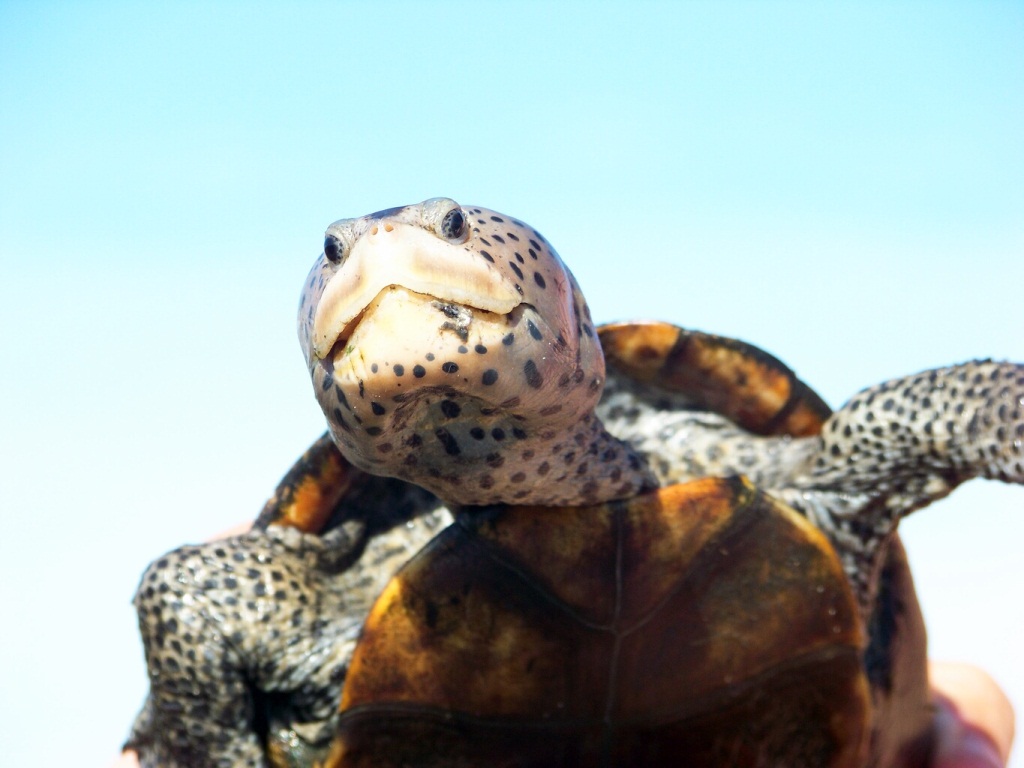
by Rick O'Connor | Mar 11, 2022
Let’s begin by stating what a diamondback terrapin is. I have found many Floridians are not familiar with the animal. It is a turtle. A turtle in the family Emydidae which includes the pond turtles, such as cooters and sliders. The big difference between terrapins and the other emydid turtles is their preference for salt water. They are not marine turtles but rather estuarine – they like brackish water.
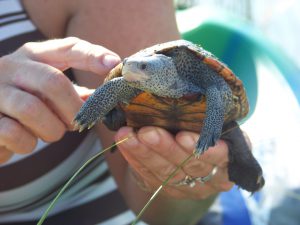
The diamond in the marsh. The diamondback terrapin.
Photo: Molly O’Connor
Their haunt are the salt marshes and mangroves of the state. Their range extends from Massachusetts down the east coast and covering all of the Gulf of Mexico over to Brownsville Texas. There are seven subspecies of the animal within that range. Five of those live in Florida and three only live in Florida. They are more abundant, and well known, in the Chesapeake Bay area where they are the mascot of the University of Maryland. In Florida they seem to be more secretive and hidden. Encounters with them are rare and there has been concern about their status for years. Though researchers are not 100% sure on their population size, it was felt that more conservation measures were needed.
Ten years ago, the issue with all turtles in the state was the illegal harvest for the food trade. All sorts of species were being captured and sent to markets overseas. The Florida Fish and Wildlife Conservation Commission (FWC) stepped in and set possession quotas on many species of Florida turtles. For terrapins, the number was two. For some, like the Suwannee Cooter, there was a no possession rule.
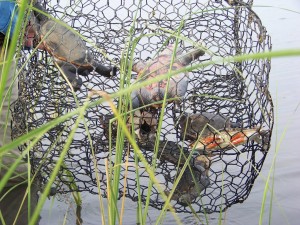
Drowned terrapins in a derelict crab trap in the Florida panhandle. (photo: Molly O’Connor)
There has also been concern with incidental capture of terrapins in crab traps. These turtles have been known to swim into the traps and drown. In the Chesapeake Bay area, they have found as many as 40 dead turtles in one trap. Not only is this bad for the turtles, but it is also bad for the crab fisherman because high numbers of dead turtles in the trap means no crabs. Studies began to develop some sort of excluder device that would keep terrapins out, but allow crabs in. Dr. Roger Wood developed a rectangle shaped wire excluder now called a By-Catch Reduction Device (BRD) that reduced the terrapin capture by 80-90% but had no significant effect on the crab catch. That was what they were looking for. This BRD has been required on crab traps up there for years.
What about Florida?
Studies using the BRD were also conducted here with the same results, but the BRD was not required. Incidental capture in crab traps does occur here but not to the extent it was happening in the Chesapeake and FWC wanted to hold off for more science before enacting the rule. BRDs were available for those who wanted them, but not required. This past December (2021) that changed.
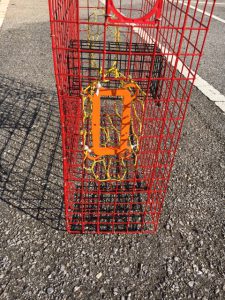
This orange plastic rectangle is a Bycatch Reduction Device (BRD) used to keep terrapins out of crab traps – but not crabs.
Photo: Rick O’Connor
In recent years there has been another issue with harvesting terrapins for the pet trade. With this, and other conservation concerns for this turtle, FWC developed a new rule for terrapins at their December 2021 meeting.
- The possession limit for terrapins has dropped from 2 to 0 – there is a no-take rule for this animal beginning March 1, 2022. Collection for scientific research will still be allowed with a valid collecting permit from the FWC. Those who currently have two or less terrapins in their possession as pets may keep them but must obtain a no cost personal possession permit to do so by May 31, 2022. Those who have terrapins within an education center may keep them but must obtain a no cost exhibit permit by May 31, 2022.
- Recreational crab traps will require the BRD device by March 1, 2023. You have a year. Those in the Pensacola area can contact me for these. I have a case of them I am willing to provide to the public.
Again, studies have shown that these BRDs do not significantly impact the crab catch. Crabs can turn sideways and still enter the traps. But reducing incidental capture of terrapins will hopefully increase their numbers in our state. For information on how to obtain the needed permits visit FWC.

by Rick O'Connor | Sep 23, 2021
These are all fish that many have heard of but know nothing about. They are not even sure what they look like. We have heard of them as a seafood product. Smoked herring, canned sardines, and anchovy pizza are popular the world over. These are one of the largest commercial species harvested in U.S. waters. In 2020 over 6 million pounds of sardines, 12 million pounds of anchovies, 41 million pounds of herring, 1.3 BILLION pounds of menhaden were harvested. The menhaden catch alone was valued at just under $200 million2. It not as large a fishery in Florida. 327,000 pounds of menhaden, 700,000 pounds of sardines, and 1.8 million pounds of herring were harvested from state waters in 2020 and at value of about $900,000 in 2020. The fish are popular in many European dishes, cat food, and menhaden oil is used in many products.
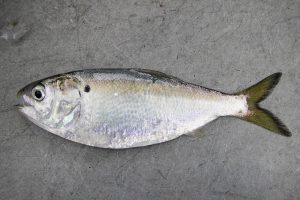
The Gulf menhaden supports a large commercial fishery in the Gulf of Mexico.
Photo: NOAA
These fishes are actually divided into two families. The herring, sardine, and menhaden are in the Family Clupeidae and are often called “clupeids”. This family includes 11 species in the northern Gulf of Mexico. Most have a “hatchet” shape to their bodies – being straight along their back with a deep curve along the ventral side, and most having a forked, or lunate, tail. They average between 2-20 inches in length and form massive schools as they travel near the surface waters filtering plankton. They are often harvested using purse seines. Large factory vessels will plow the waters searching for the large schools. Often, they will use aerial assistance to search such as small airplanes or ultralights. Once spotted, small chase boats will be launched from the factory vessel hauling the large purse seine around the school. Once that is completed a large weight called a “tommy” is dropped that “zips” the purse shut and captures the fish. There is little bycatch in this method.
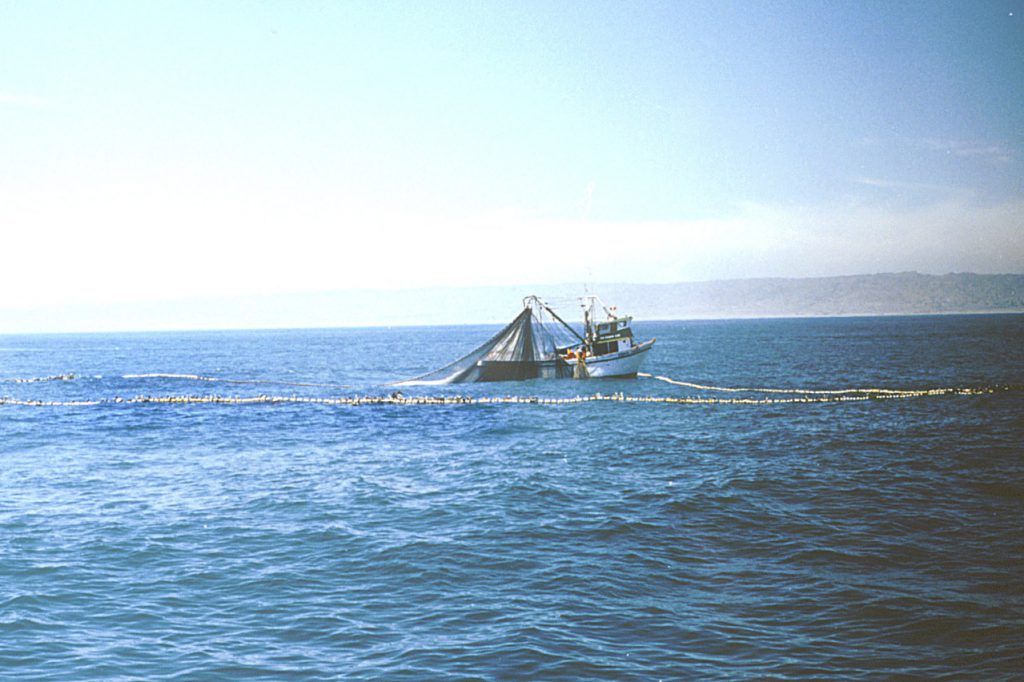
Purse seining in the Pacific Ocean.
Photo: NOAA
The anchovies are found in the family Engraulidae. They differ in that they are more streamlined in shape and their mouths are larger / body size than the clupeids. Though there is no commercial fishery for them in Florida, they comprise one of the largest groups of schooling fish in the northern Gulf of Mexico. Hoese and Moore mention that the local species are too small for a fishery. The five native species average between 2.5-5.5 inches in length1. Some marine biologists consider anchovies as an “environmental canary”, or indicator species. Their presence can suggest good water quality. I have often caught them in seines along the beach in the Pensacola area. They resemble the very common silverside minnow in that they have a silver stripe running down their sides. But they differ in that they (a) only have a single dorsal fin (silversides have two), and (b) their snouts extend to a point resembling the head of a shark.
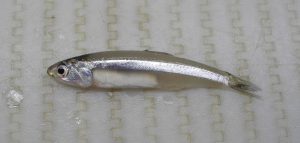
This striped anchovy resembles a silver side but differs with the shape of its snout and the number of dorsal fins.
Photo: NOAA
The distribution and biogeography of this group of fishes is all over the place. The round herring (Etrumeus teres) has few barriers and is found from the Bay of Fundy (at the Canadian/Maine border) to the Pacific Ocean1! A few species have the classic “Carolina” distribution – meaning they are found from North Carolina south, the entire Gulf of Mexico, and down to Brazil. For whatever reason (currents, water temperature, other) they do not venture north of the Carolinas and are probably impacted by the large amount of freshwater entering the Atlantic Ocean near the Amazon River.
Twp species are restricted by tropical conditions. The tiny dwarf herring (Jenkinsia lamprotaenia) and the Spanish sardine (Sardinella anchovia) are both listed as being restricted by water temperatures, though I have captured plenty of the Spanish sardines in the Pensacola area.
Some species are restricted to either the eastern or western Gulf of Mexico. Usually, the barrier for this distribution is the Mississippi River. Like the Amazon, there is a large plume of highly turbid/low salinity water extending into the Gulf of Mexico which keeps some species from crossing. Hoese and Moore report the Alabama shad (Alosa alabamae) only from the area between the Mississippi River and the Florida panhandle. The Mississippi River to one side, and the Apalachicola on the other.

Clupeids, like this Pacific sardine, for m large schools can consist of literally millions of fish.
Photo: NOAA
And finally, there is a spatial distribution with some species between freshwater, estuaries, and the open shelf. Two species, the threadfin shad (Dorosoma petenense) and the gizzard shad (Dorosoma cepedianum) are more associated with freshwater. The scaled sardine (Harengula pensacolae) is more common on the open shelf of the Gulf.
We all know the names of these fish but are unaware of their general biology and importance to commercial fisheries around the world. Many are common in our estuaries and play an important role in the health of the overall ecology. They are important members of the “panhandle fish family”.
References
1 Hoese, H.D., R.H. Moore. 1977. Fishes of the Gulf of Mexico; Texas, Louisiana, and Adjacent Waters. Texas A&M Press, College Station TX. Pp. 327.
2 NOAA Fisheries. 2021. Commercial Landings. https://www.fisheries.noaa.gov/foss/f?p=215:200:2082956461436::NO:::.
3 Florida Commercial Landings. 2021. Florida Fish and Wildlife Conservation Commission. https://myfwc.com/research/saltwater/fishstats/commercial-fisheries/landings-in-florida/.
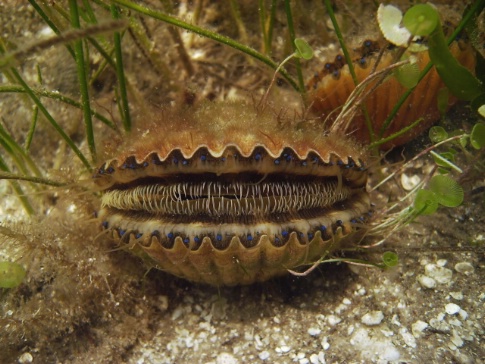
by Rick O'Connor | Aug 27, 2021
For those who lived in the Pensacola Bay area 50 or so years ago, this question comes up from time to time. By scallop I am speaking of the bay scallop (Argopecten irradians), the one sought by so many scallopers then and now. This relatively small bivalve sits on beds of turtle grass, gazing with their ice blue eyes, filtering the water for plankton and avoiding numerous predators. They only live for a year, maybe two. They aggregate in relatively large groups and mass spawn. Releasing male gametes first, then female, fertilizing externally in the water column, to create the next generation.

Bay Scallop Argopecten iradians
http://myfwc.com/fishing/saltwater/recreational/bay-scallops/
These are unique bivalves in that they can swim… sort of. When conditions are not good, or a predator is detected, they can use their single adductor muscle to open and close the shells creating a current of expelling water that “pushes” them along and off the bottom. They were once found from Pensacola to Miami… but no longer. Scallops have become almost nondetectable in much of their historic range. Today they congregate in the Big Bend area of the state, and there they are heavily harvested.
What happened?
Well, if you look at the variety of causes for species decline around the globe habitat loss is usually at the top of the list. The habitat of the bay scallop are seagrass beds. There are many publications reporting the loss of seagrasses across the Gulf and Atlantic coast. Locally we know that the historic beds of the Pensacola Bay system have declined. We also know that some of those beds have shown some recovery in the last 20 years. But was the loss enough to cause the decline of the scallop?
Studies show that there is a strong association between seagrasses and scallops. The planktonic larva typically attached to grass blades a week or two after fertilization. This seems essential to reduce predation. Once they drop from the blades, vegetative cover is important for their survival. This suggests yes – any loss of seagrass could begin the loss of bay scallops.
What about water quality?
We do know that scallops need more saline brackish water – at (or above) 20 parts per thousand (20‰); 10‰ or less is lethal. Sea Grant is currently working with citizen scientists in Escambia County to monitor the salinity of area waters weekly. Though we do not believe the data is usable until we have 100 readings from each location, early numbers suggest that locations in Big Lagoon and Santa Rosa Sound are at 20‰ threshold. We do not know whether run-off engineering of the 1970s may have lowered the salinity to cause a die-off, and one would think (since they can swim) they would move to a better location. However, if salinities were low across much of their local range, and seagrasses were not available in areas where salinities were good, this could have a devasting impact on their numbers.
Then there is sedimentation. Studies show that young scallops (<20mm) that do not have seagrass to attach to settle on silty bottoms and their survival is very low. And then there are toxic metals, and other contaminants that scallops may have little tolerance for. It is known that juvenile scallops have a low tolerance for mercury.
Disease?
One study from the Tampa Bay area indicated that there was little loss of scallops due to disease and parasites.
And then there is overharvesting…
Scallops are mass spawners and there needs to be high numbers of adults near each other for reproduction to be successful. If people are taking too many, this can lead to more spaced adults and less chance of successful fertilization. This combined with environmental stressors probably did our populations in.
According to a publication from Sarasota Bay Estuary Program in 2010, populations of less than five scallops / 600m2 is considered collapsed. Sea Grant has been conducting volunteer scallop searches in the Pensacola Bay area for the last five years. In that time, we have found only one live scallop… we have collapsed. During the 2021 Scallop Search, 17 volunteers surveyed 4000m2 and found no live scallops. However, reports of live scallops outside of our surveys indicate they are still there. We will see what the future holds.
References
Castagna, Michael, Culture of the Bay Scallop, Argopecten irradians, in Virginia (1975). Marine Fisheries
Review, 37(1), 19-24.
https://scholarworks.wm.edu/vimsarticles/1200
Leverone, J.R. 1993. Environmental Requirements Assessment of the Bay Scallop
Argopecten Irradians Concentricus. Final Report. Tampa Bay Estuary Program. Pp.82.
Leverone, J.R., S.P. Geiger, S.P. Stephenson, and W.S. Arnold. 2010. Increase in Bay Scallop (Argopecten irradians) Populations Following Releases of Competent Larvae in Two West Florida Estuaries. Journal of Shellfish Research. Vol. 9, No. 2, pp. 395-406.

by Ray Bodrey | Apr 20, 2021

Scott Jackson, UF/IFAS Extension Bay County & Florida Sea Grant
Ray Bodrey, UF/IFAS Extension Gulf County & Florida Sea Grant
Erik Lovestrand, UF/IFAS Extension Franklin County & Florida Sea Grant
Can you remember where you were one year ago last April? The uncertainty of each day seemed to go on forever. At this time last year, we were planning several education programs that eventually had to be canceled or migrated to online events. Scallop Sitters was one of our cooperative volunteer programs with Florida Fish and Wildlife (FWC) that was postponed during the pandemic in 2020. Thankfully, FWC biologists continued restoration work last year in the region with good results and steps forward. However, there was something painfully absent in these efforts – you!
One of the lessons last year taught us, is to appreciate our opportunities – whether it is to be with your family, friends, or serve your community freely through volunteer service. Some new service opportunities appeared while others were placed on hold. Thankfully, we are excited to announce the Scallop Sitters Citizen Scientist Restoration Program is returning to our area in St. Andrew, St. Joe, and Apalachicola Bays this summer!
Historically, populations of bay scallops were in large numbers and able to support fisheries across many North Florida bays, including St Andrew Bay. Consecutive years of poor environmental conditions, habitat loss, and general “bad luck” resulted in poor annual scallop production and caused the scallop fishery to close. Bay scallops are a short-lived species growing from babies to spawning adults and dying in about a year. Populations can recover quickly when growing conditions are good and can be decimated when conditions are bad.
An opportunity to jump start restoration of North Florida’s bay scallops came in 2011. Using funding as a result of the Deepwater Horizon Oil Spill, a multi-county scallop restoration program was proposed and eventually established in 2016. Scientists with FWC use hatchery reared scallops obtained from parents or broodstock from local bays to grow them in mass to help increase the number of spawning adults near critical seagrass habitat.
FWC also created another program where volunteers can help with restoration called “Scallop Sitters” in 2018 and invited UF/IFAS Extension to help manage the volunteer portion of the program in 2019 which led to targeted efforts in Gulf and Bay Counties.
After a year’s hiatus, UF/IFAS Extension is partnering with FWC again in Bay and Gulf Counties and expanding the program into Franklin County. Despite initial challenges with rainfall, stormwater runoff, and low salinity, our Scallop Sitter volunteers have provided valuable information to researchers and restoration efforts, especially in these beginning years of the program.
Volunteers manage predator exclusion cages of scallops, which are either placed in the bay or by a dock. The cages provide a safe environment for the scallops to live and reproduce, and in turn repopulate the bays. Volunteers make monthly visits from June until January to their assigned cages where they clean scallops removing attached barnacles and other potential problem organisms. Scallop Sitters monitor the mortality rate and collect salinity data which determines restoration goals and success in targeted areas.
You are invited! Become a Scallop Sitter
1.Register on Eventbrite
2.Take the Pre-Survey (link will be sent to your email address upon Eventbrite Registration)
3.View a Virtual Workshop in May
4.Attend a Zoom virtual Q & A session in May or June with multiple dates / times available
5.Pick up supplies & scallops on June 17 with an alternate pick-up date to be announced
UF/IFAS Extension is an Equal Opportunity Institution.
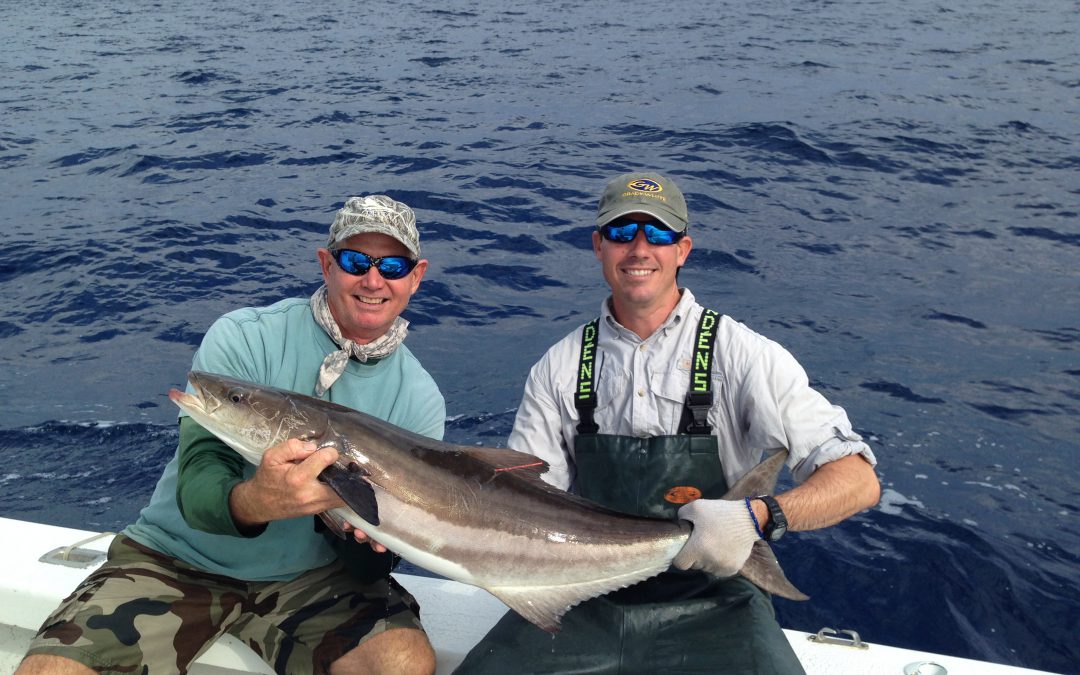
by Erik Lovestrand | Mar 11, 2021
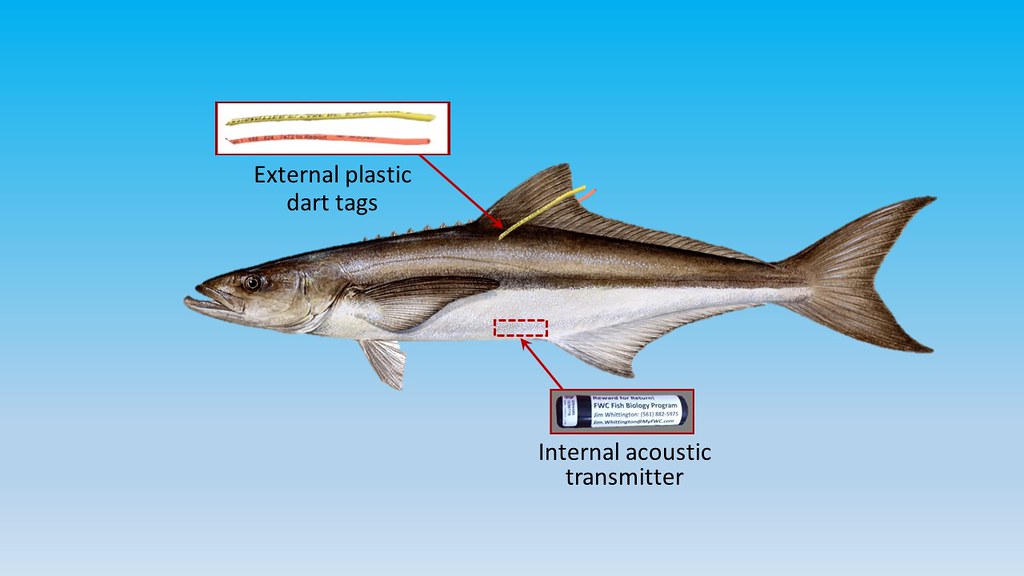
Cobia Researchers use Transmitters as well as Tags to Gather Data on Migratory Patterns
I must admit to having very limited personal experience with Cobia, having caught one sub-legal fish to-date. However, that does not diminish my fascination with the fish, particularly since I ran across a 2019 report from the Gulf States Marine Fisheries Commission titled “Management Profile for Gulf of Mexico Cobia.” This 182-page report is definitely not a quick read and I have thus far only scratched the surface by digging into a few chapters that caught my interest. Nevertheless, it is so full of detailed life history, biology and everything else “Cobia” that it is definitely worth a look. This posting will highlight some of the fascinating aspects of Cobia and why the species is so highly prized by so many people.
Cobia (Rachycentron canadum) are the sole species in the fish family Rachycentridae. They occur worldwide in most tropical and subtropical oceans but in Florida waters, we actually have two different groups. The Atlantic stock ranges along the Eastern U.S. from Florida to New York and the Gulf stock ranges From Florida to Texas. The Florida Keys appear to be a mixing zone of sorts where Cobia from both stocks go in the winter. As waters warm in the spring, these fish head northward up the Atlantic and Gulf coasts of Florida. The Northern Gulf coast is especially important as a spawning ground for the Gulf stock. There may even be some sub-populations within the Gulf stock, as tagged fish from the Texas coast were rarely caught going eastward. There also appears to be a group that overwinters in the offshore waters of the Northern Gulf, not making the annual trip to the Keys. My brief summary here regarding seasonal movement is most assuredly an over-simplification and scientists agree more recapture data is needed to understand various Cobia stock movements and boundaries.
Worldwide, the practice of Cobia aquaculture has exploded since the early 2000’s, with China taking the lead on production. Most operations complete their grow-out to market size in ponds or pens in nearshore waters. Due to their incredible growth rate, Cobia are an exceptional candidate for aquaculture. In the wild, fish can reach weights of 17 pounds and lengths of 23 inches in their first year. Aquaculture-raised fish tend to be shorter but heavier, comparatively. The U.S. is currently exploring rules for offshore aquaculture practices and cobia is a prime candidate for establishing this industry domestically.
Spawning takes place in the Northern Gulf from April through September. Male Cobia will reach sexual maturity at an amazing 1-2 years and females within 2-3 years. At maturity, they are able to spawn every 4-6 days throughout the spawning season. This prolific nature supports an average annual commercial harvest in the Gulf and East Florida of around 160,000 pounds. This is dwarfed by the recreational fishery, with 500,000 to 1,000,000 pounds harvested annually from the same region.
One of the Cobia’s unique features is that they are strongly attracted to structure, even if it is mobile. They are known to shadow large rays, sharks, whales, tarpon, and even sea turtles. This habit also makes them vulnerable to being caught around human-made FADs (Fish Aggregating Devices). Most large Cobia tournaments have banned the use of FADs during their events to recapture a more sporting aspect of Cobia fishing.
To wrap this up I’ll briefly recount an exciting, non-fish-catching, Cobia experience. My son and I were in about 35 feet of water off the Wakulla County coastline fishing near an old wreck. Nothing much was happening when I noticed a short fin breaking the water briefly, about 20 yards behind a bobber we had cast out with a dead pinfish under it. I had not seen this before and was unaware of what was about to happen. When the fish ate that bait and came tight on the line the rod luckily hung up on something in the bottom of the boat. As the reel’s drag system screamed, a Cobia that I gauged to be 4-5 feet long jumped clear out of the water about 40 yards from us. Needless to say, by the time we gained control of the rod it was too late; a heartbreaking missed opportunity. Every time we have been fishing since then, I just can’t stop looking for that short, pointed fin slicing towards one of our baits.













